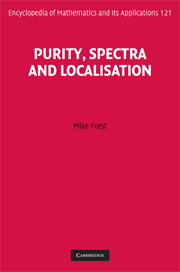
-
Select format
-
- Publisher:
- Cambridge University Press
- Publication date:
- March 2013
- June 2009
- ISBN:
- 9781139644242
- 9780521873086
- Dimensions:
- (234 x 156 mm)
- Weight & Pages:
- 1.35kg, 798 Pages
- Dimensions:
- Weight & Pages:
- Series:
- Encyclopedia of Mathematics and its Applications (121)
You may already have access via personal or institutional login- Series:
- Encyclopedia of Mathematics and its Applications (121)
Book description
It is possible to associate a topological space to the category of modules over any ring. This space, the Ziegler spectrum, is based on the indecomposable pure-injective modules. Although the Ziegler spectrum arose within the model theory of modules and plays a central role in that subject, this book concentrates specifically on its algebraic aspects and uses. The central aim is to understand modules and the categories they form through associated structures and dimensions, which reflect the complexity of these, and similar, categories. The structures and dimensions considered arise particularly through the application of model-theoretic and functor-category ideas and methods. Purity and associated notions are central, localisation is an ever-present theme and various types of spectrum play organising roles. This book presents a unified, coherent account of material which is often presented from very different viewpoints and clarifies the relationships between these various approaches.
Reviews
'This book is an account of a fruitful interaction between algebra, mathematical logic, and category theory. … provides relevant background material and a wealth of illustrative examples. An extensive index and thorough referencing also make this book an ideal, comprehensive reference.'
Source: L’Enseignement Mathématique
'This very interesting book is written so that it will be useful for graduate students and experienced researchers. It is worth to be mentioned that Mike Prest introduced in this book some very useful appendixes which come to help the reader to become familiar with the language of model theory. The book contains a lot of illuminating examples which are also very helpful for the reader.'
Source: Zentralblatt MATH
Contents
Metrics
Altmetric attention score
Full text views
Full text views help Loading metrics...
Loading metrics...
* Views captured on Cambridge Core between #date#. This data will be updated every 24 hours.
Usage data cannot currently be displayed.
Accessibility standard: Unknown
Why this information is here
This section outlines the accessibility features of this content - including support for screen readers, full keyboard navigation and high-contrast display options. This may not be relevant for you.
Accessibility Information
Accessibility compliance for the PDF of this book is currently unknown and may be updated in the future.


